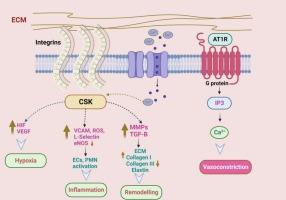静脉曲张的分子和基因研究
IF 0.9
Q4 GENETICS & HEREDITY
引用次数: 0
摘要
静脉曲张的特征是下肢静脉扩大、扭曲和弯曲。已确定的静脉曲张病因包括年龄、性别、直立性和遗传。然而,许多其他因素仍未确定。本文综述了影响静脉曲张发病机制的各种关键因素,包括整合素、血流敏感离子通道(Ca2+和K+)、血管紧张素II型1受体(AT1R)、基质金属蛋白酶(MMPs)、嘌呤能受体、血管内皮生长因子(VEGF)及其受体、弹性蛋白、胶原蛋白、雌激素和钙离子。综述了血管细胞黏附分子-1 (VCAM-1)、细胞间黏附分子-1 (ICAM-1)、内皮白细胞黏附分子(ELAM-1)和血管性血液病因子在静脉张力调节中的作用。对静脉曲张的侵入性和非侵入性治疗方法进行了探讨。对静脉曲张的研究不断扩大,以确定确切的病因和潜在的机制。合并症发病率的上升也引起了人们对医疗保健的日益关注。这些因素强调需要确定疾病的潜在病理,以确定新的,更有效的药物干预目标。本文章由计算机程序翻译,如有差异,请以英文原文为准。

Molecular and genetic insights into varicose veins
Varicose veins are characterized by enlarged, twisted, and tortuous veins in the lower extremities. The identified etiologies of varicose veins include age, sex, orthostasis, and genetics. However, numerous other factors remain undetermined. This review explores the various key elements contributing to the pathogenesis of varicose veins, including integrins, flow-sensitive ion channels (Ca2+ and K+), angiotensin II type 1 receptor (AT1R), matrix metalloproteinases (MMPs), purinergic receptors, vascular endothelial growth factor (VEGF) and its receptors, elastin, collagen, estrogen, and calcium ions. Also, this review covers the role of vascular cell adhesion molecule-1 (VCAM-1), intercellular adhesion molecule-1 (ICAM-1), endothelial leucocyte adhesion molecule (ELAM-1), and von Willebrand factor on veno-tonicity. Both an invasive and non-invasive therapeutic approach against varicose veins were explored. Research on varicose veins continues to expand in an effort to identify the precise causal factors and underlying mechanisms. The rising incidence of comorbidities also presents an increasing concern for healthcare. These factors highlight the need to define the disease's underlying pathology in order to identify new, more effective drug intervention targets.
求助全文
通过发布文献求助,成功后即可免费获取论文全文。
去求助
来源期刊

Gene Reports
Biochemistry, Genetics and Molecular Biology-Genetics
CiteScore
3.30
自引率
7.70%
发文量
246
审稿时长
49 days
期刊介绍:
Gene Reports publishes papers that focus on the regulation, expression, function and evolution of genes in all biological contexts, including all prokaryotic and eukaryotic organisms, as well as viruses. Gene Reports strives to be a very diverse journal and topics in all fields will be considered for publication. Although not limited to the following, some general topics include: DNA Organization, Replication & Evolution -Focus on genomic DNA (chromosomal organization, comparative genomics, DNA replication, DNA repair, mobile DNA, mitochondrial DNA, chloroplast DNA). Expression & Function - Focus on functional RNAs (microRNAs, tRNAs, rRNAs, mRNA splicing, alternative polyadenylation) Regulation - Focus on processes that mediate gene-read out (epigenetics, chromatin, histone code, transcription, translation, protein degradation). Cell Signaling - Focus on mechanisms that control information flow into the nucleus to control gene expression (kinase and phosphatase pathways controlled by extra-cellular ligands, Wnt, Notch, TGFbeta/BMPs, FGFs, IGFs etc.) Profiling of gene expression and genetic variation - Focus on high throughput approaches (e.g., DeepSeq, ChIP-Seq, Affymetrix microarrays, proteomics) that define gene regulatory circuitry, molecular pathways and protein/protein networks. Genetics - Focus on development in model organisms (e.g., mouse, frog, fruit fly, worm), human genetic variation, population genetics, as well as agricultural and veterinary genetics. Molecular Pathology & Regenerative Medicine - Focus on the deregulation of molecular processes in human diseases and mechanisms supporting regeneration of tissues through pluripotent or multipotent stem cells.
 求助内容:
求助内容: 应助结果提醒方式:
应助结果提醒方式:


